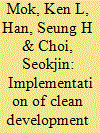|
|
|
Sort Order |
|
|
|
Items / Page
|
|
|
|
|
|
|
| Srl | Item |
| 1 |
ID:
127273


|
|
|
|
|
| Publication |
2014.
|
| Summary/Abstract |
As government and industry plan to reduce energy consumption in building stock, there is a need to forecast the uptake of retrofit packages across building stock over time. To address this challenge a diffusion model was set up and applied to office building stock across New South Wales (NSW) in Australia, accommodating a high spatial resolution and temporal capability for projecting uptake of technology packages characterised by multiple variables. Six retrofit packages were set up for the diffusion model, which ranged from inexpensive services and manuals through to mid-priced packages involving energy efficient T5 lighting and solar hot water through to expensive packages such as chilled beams and Solar PV. We evaluated the model using a base case and two policy programs, representing the Green Building Fund and Environmental Upgrade Agreements. These were recent incentive programs funded by the Australian government to accelerate the uptake of retrofit packages, by providing financial support to upfront expenditures and removing barriers to retrofit. By forecasting uptake of each retrofit package to 2032 under each program, we demonstrate how the model can be a valuable resource in tailoring expensive government programs and increasing their effectiveness.
|
|
|
|
|
|
|
|
|
|
|
|
|
|
|
|
| 2 |
ID:
168359


|
|
|
|
|
| Summary/Abstract |
As the residential sector is becoming increasingly important in the total energy consumption and appliance ownership is a significant but under-examined driver, this study investigates the relationship between income inequality and appliance ownership using panel data from the China Health and Nutrition Survey (CHNS). We find that income inequality has negative impacts on appliance penetration rate across specifications, except for the initial development stage. On average, households start adopting air conditioners at a threshold of over 60,000 (2011 RMB) based on annual income, much higher than TV, fridge and washer (8500–9000 RMB). The empirical results validate the S-shape curve of appliance established in the literature. To understand the magnitude of the impact and policy implications, we further simulate the impact of poverty alleviation and the penetration paths under inclusive versus exclusive income growth. Our results demonstrate that current poverty line is too low to achieve appliance adoption – a signal for modern life-styles. In addition, a more inclusive growth path could lead to much higher penetration for regions that have relatively low growth rate.
|
|
|
|
|
|
|
|
|
|
|
|
|
|
|
|
| 3 |
ID:
127275


|
|
|
|
|
| Publication |
2014.
|
| Summary/Abstract |
Greenhouse gas emissions due to human activities are the main contributors to global climate change, a problem that should not be ignored. Through the clean development mechanism (CDM) introduced under the Kyoto Protocol, developing countries are able to earn certified emission reduction (CER) credits through a myriad of emission reduction projects. This study aims to explore the potential of implementing CDM projects in the construction and built environment (C&BE) industry, which has been criticized for not only consuming an enormous amount of resources, but also for contributing to adverse environmental health. In this research, we limit the boundary of the C&BE industry to include the planning, procurement, construction, occupation and refurbishment/demolition phases of a project's life cycle. Surveys and in-depth follow-up interviews with experts have generated useful insights pertaining to CDM potential and its adaptation into the C&BE industry. From this foundation, this paper evaluates the current obstacles to CDM and presents feasible suggestions to increase CDM projects related to the C&BE industry.
|
|
|
|
|
|
|
|
|
|
|
|
|
|
|
|
| 4 |
ID:
179745


|
|
|
|
|
| Summary/Abstract |
In countries highly dependent on coal and oil, the substitution of relatively cleaner energy for fossil fuels in industrial and residential sectors (cleaner energy substitution, or CES) is conducive to technology advancement and pollution abatement. Since CES is a process met with resistance by a portion of enterprises in China, this study will investigate the roles of external factors by simulating CES diffusion in enterprise networks. The PEST (political, economic, social, and technological factors) analysis framework, referencing corporation strategy management, is employed to select potential external factors of CES diffusion. The results show that factors will affect the diffusion of CES by changing the payoffs of different enterprises. Reducing the costs of cleaner energy and related equipment will promote diffusion. Besides, improving consumer preferences for green products, consolidating responses to public complaints on pollution and promoting information exchange among enterprises are beneficial to diffusion. It is novel that this paper demonstrates that diffusion will be hindered by supply interruptions of cleaner energy, which means that stable supply after a wide range of adoption is important. Focusing on PEST factors, this study introduces a useful framework to investigate the potential factors of enterprises’ green decisions and behaviours and offers fresh insights into promoting CES adoption and energy transition in developing countries.
|
|
|
|
|
|
|
|
|
|
|
|
|
|
|
|
| 5 |
ID:
149908


|
|
|
|
|
| Summary/Abstract |
Among the various alternatives available to reduce greenhouse gas (GHG) emissions, carbon capture and storage (CCS) is considered to be a prospective technology that could both improve economic growth and meet GHG emission reduction targets. Despite the importance of CCS, however, studies of technology and demand forecasting for CCS are scarce. This study bridges this gap in the body of knowledge on this topic by forecasting CCS technology and demand based on an integrated model. For technology forecasting, a logistic model and patent network analysis are used to compare the competitiveness of CCS technology for selected countries. For demand forecasting, a competition diffusion model is adopted to consider competition among renewable energies and forecast demand. The results show that the number of patent applications for CCS technology will increase to 16,156 worldwide and to 4,790 in Korea by 2025. We also find that the United States has the most competitive CCS technology followed by Korea and France. Moreover, about 5 million tCO2e of GHG will be reduced by 2040 if CCS technology is adopted in Korea after 2020.
|
|
|
|
|
|
|
|
|
|
|
|
|
|
|
|
| 6 |
ID:
169752


|
|
|
|
|
| Summary/Abstract |
The transportation sector is responsible for nearly a quarter of greenhouse gases emissions (GHG); thus, incisive policies are necessary to mitigate the sector’s effect on climate change. Promoting alternative fuel vehicles (AFV) is an essential strategy to reduce GHG emissions in the short term. Here, we study the effects of governmental incentives on the diffusion of ethanol and flex-fuel vehicle technologies in Brazil. We use a multi-generation diffusion model which assumes that new technologies introduce fresh market potential for adopters as well as upgraders from established technologies. Our analysis indicates that tax rates affected the adoption of both gasoline and ethanol technology, but for flex vehicles, the effect of taxation is not significant. The effect of fuel price shocks during the 1990s meant that the introduction of ethanol technology made no significant impact on market potential and a negative word-of-mouth effect contributed to the technology’s failure. In contrast, the introduction of flex technology led to almost a doubling of total market potential. As policy suggestions, we emphasise the importance of tax reduction in addition to promoting versatile technologies, which insulate consumers against price fluctuations.
|
|
|
|
|
|
|
|
|
|
|
|
|
|
|
|
|
|
|
|
|